show/hide words to know
Antennae: the long, thin structures on the head of some animals that are used to sense surroundings.
Appendage: a part of animal that projects from the main body and has a specific use and appearance, like arms, legs, and antenna.
Compound eye: an eye made of smaller units that work together to produce an image. Commonly found in insects and other arthropods.
Is It a Boy or Girl Bee?
How can you tell the difference between a female (worker) and a male (drone) honey bee? There are several things you want to check out when you look for female and male bees.
- First look at the eyes. Drones have huge eyes that touch at the top of the head. Female worker bees have much smaller eyes that are well separated on the sides of their heads. The male’s eyes are so much larger because they need to find a potential queen in flight.
- Second, males are slightly larger than a female worker bee.
- Third, look very closely at the segmented portion of the bee’s antennae. The antennae of bees break into two long portions, kind of like our arms. The sections are the scape and the flagellum. The scape is the un-segmented appendage attached to the bee’s head. The scape acts like our upper arm. It has a large degree of rotation and connects the appendage to the rest of the body. The flagellum is the segmented appendage, furthest from the bees head, connected to the scape by the pedicel. The pedicel acts like an elbow joint between the scape and flagellum. Finally, you can examine the number of segments on the flagellum to tell if a bee is male or female. Females have 10 segments on their flagellum and males have 11 segments.
- You will also notice that male bees do not have stingers. This is because the stinger of social insects is a modified ovipositor, which is what female insects use to lay eggs. Since males cannot produce and lay eggs, they also do not have a stinger. Drones only have one real job in the colony and that is to mate with the queen bee.
Bee Identification Challenge
There are a lot of insects that like to pretend to be a bee. Can you identify the honey bee in this group? Are any of them bees of any type? Click on the images that you think are bees to find out if your are correct.
Can You Find the Bee in All These Pictures?
 |  |
| Contestant number 1 | Contestant number 2 |
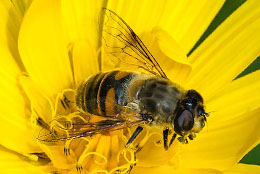 | 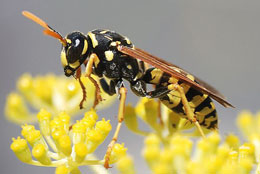 |
| Contestant number 3 | Contestant number 4 |
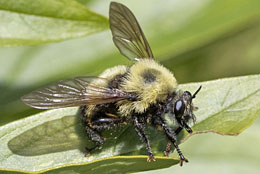 | 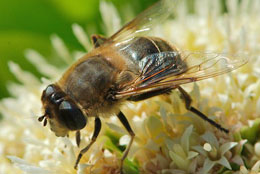 |
| Contestant number 5 | Contestant number 6 |
 | 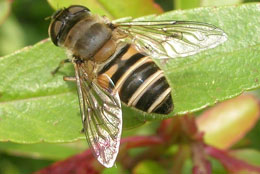 |
| Contestant number 7 | Contestant number 8 |
Did you find the honey bee? Why do you think some insects pretend to be a bee?
How to Identify a Honey Bee
The easiest way to tell a bee from another flying insect is their general body shape, hair, antennae, eye shape, mouthparts, and hind legs.
- First, bees generally have very little or no obvious thinning of the body between the abdomen and thorax. This is the easiest way to tell a bee from a wasp.
- Second, bees are generally all covered in hair. This can be the giant fuzzy bumblebees, or the less noticeable hair on the bright and shiny orchid bees.
- Third, bees and other hymenopterans, like wasps, have two long independently moving appendages on their head called antennae. The antennae of bees are divided in two stick-like segments connected with a joint like our elbow in the middle. Bees and other insects use their antennae for many different things including: smell, taste and touch.
- Fourth, you can look at the shape of the eyes. Bees have two distinct compound eyes on the sides of their heads and three very small simple eyes called ocelli in a triangle pattern on the top of their head. The eyes make it easy to tell the difference between a bee and a fly.
- Fifth, the mouthparts of bees make them easy to spot due to their pronounced, tongue-like structure called a proboscis. The proboscis is used to drink nectar inside a flower. Wasps, unlike bees, are generally predatory and have a much smaller proboscis.
- Lastly, the hind legs of bees usually have an enlarged segment used to carry pollen. The hind legs have a small basket, called corbiculae, made of hairs they use to hold the pollen while the bees are flying.
View Citation
Bibliographic details:
- Article: Bee Identification
- Author(s): Christopher M. Jernigan
- Publisher: Arizona State University School of Life Sciences Ask A Biologist
- Site name: ASU - Ask A Biologist
- Date published: June 13, 2017
- Date accessed: April 17, 2024
- Link: https://askabiologist.asu.edu/honey-bee-identification
APA Style
Christopher M. Jernigan. (2017, June 13). Bee Identification. ASU - Ask A Biologist. Retrieved April 17, 2024 from https://askabiologist.asu.edu/honey-bee-identification
Chicago Manual of Style
Christopher M. Jernigan. "Bee Identification". ASU - Ask A Biologist. 13 June, 2017. https://askabiologist.asu.edu/honey-bee-identification
Christopher M. Jernigan. "Bee Identification". ASU - Ask A Biologist. 13 Jun 2017. ASU - Ask A Biologist, Web. 17 Apr 2024. https://askabiologist.asu.edu/honey-bee-identification
MLA 2017 Style

One way to tell the boys from the girls is their eyes.
Be Part of
Ask A Biologist
By volunteering, or simply sending us feedback on the site. Scientists, teachers, writers, illustrators, and translators are all important to the program. If you are interested in helping with the website we have a Volunteers page to get the process started.








